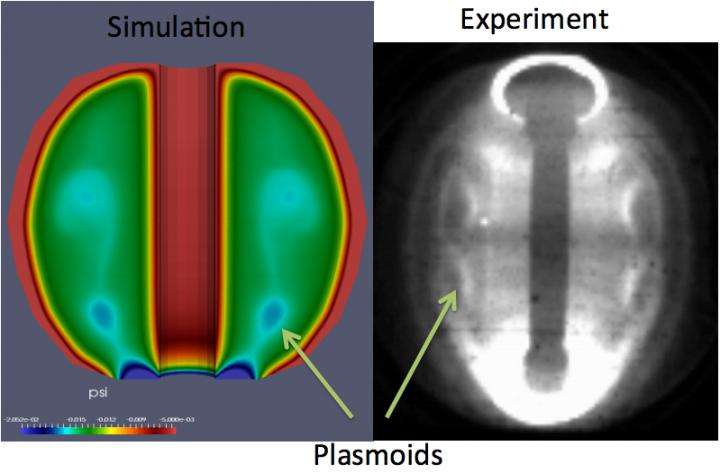Launching fusion reactions without a central magnet, or solenoid

The tokamak is an experimental chamber that holds a gas of energetic charged particles, plasma, for developing energy production from nuclear fusion. Most large tokamaks create the plasma with solenoids—large magnetic coils that wind down the center of the vessels and inject the current that starts the plasma and completes the magnetic field that holds the superhot gas in place. But future tokamaks must do without solenoids, which run in short pulses rather than for weeks or months at a time as commercial fusion power plants will have to do.
Recent computer simulations have suggested a novel method for launching the plasma without using solenoids. The simulation modeling shows the formation of distinct, current carrying magnetic structures called plasmoids that can initiate the plasma and complete the complex magnetic field.
Everything starts with magnetic field lines, or loops, that rise through an opening in the floor of the tokamak. As the field lines are electrically forced to expand into the vessel, a thin layer, or sheet, of electrical current can form. Through a process called magnetic reconnection, the sheet can break and form a series of ring-shaped plasmoids that are the magnetic equivalent to the bubble rings created by dolphins.
The computationally predicted plasmoids have been confirmed with fast-camera images inside the National Spherical Torus Experiment (NSTX), the major fusion facility at the U.S. Department of Energy's Princeton Plasma Physics Laboratory (PPPL); the facility has since been upgraded. The plasmoids merge to form a large ring carrying up to 400,000 amperes of current, creating a plasma start-up phase inside the tokamak.
This advanced modeling of plasmoids also led to another major finding: the conditions under which a large volume of field line closure and maximum start-up current can be achieved by the upgrade of the National Spherical Torus Experiment (NSTX-U).
Plasmoid-like structures are also observed in nature such as during eruptive solar events. The global plasmoid formation observed in the tokamak sheds new light on the magnetic reconnection process and the trigger mechanism of solar flares. These findings also reveal that the same plasmoid-mediated reconnection that occurs in space has a leading role to play in closing magnetic field lines and starting up plasma in NSTX-U.
More information: meetings.aps.org/Meeting/DPP16/Session/DI2.4
Provided by American Physical Society





















